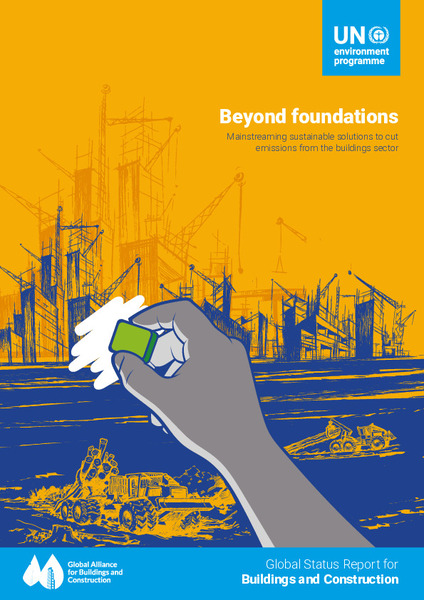| dc.contributor | Industry and Economy Division | en_US |
| dc.contributor.author | United Nations Environment Programme | en_US |
| dc.contributor.author | Global Alliance for Buildings and Construction | |
| dc.contributor.other | Hamilton, Ian | |
| dc.contributor.other | Kennard, Harry | |
| dc.contributor.other | Rapf, Oliver | |
| dc.contributor.other | Amorocho, Jerson | |
| dc.contributor.other | Steuwer, Sybil | |
| dc.contributor.other | Kockat, Judit | |
| dc.contributor.other | Toth, Zsolt | |
| dc.date.accessioned | 2024-03-06T07:46:34Z | |
| dc.date.available | 2024-03-06T07:46:34Z | |
| dc.date.issued | 2024-03 | |
| dc.identifier.isbn | 978-92-807-4131-5 | |
| dc.identifier.other | CLI/2621/NA | |
| dc.identifier.uri | https://wedocs.unep.org/20.500.11822/45095 | |
| dc.description | The Global Status Report for Buildings and Construction (Buildings-GSR), a report published by the UN Environment Programme (UNEP) and the Global Alliance for Buildings and Construction (GlobalABC), provides an annual snapshot of the progress of the buildings and construction sector on a global scale. The Buildings-GSR reviews the status of policies, finance, technologies, and solutions to monitor whether the sector is aligned with the Paris Agreement goals. It also provides stakeholders with evidence to persuade policymakers and the overall buildings and construction community to take action.
As outlined in this edition, the buildings and construction sector contributes significantly to global climate change, accounting for about 21 per cent of global greenhouse gas emissions. In 2022, buildings were responsible for 34 per cent global energy demand and 37 per cent of energy and process-related carbon dioxide (CO2) emissions.
The 2022 update of the Global Buildings Climate Tracker (GBCT) paints a concerning picture: the gap between the current state and the desired decarbonisation path is significant. To align with the 2030 milestone, an annual increase of ten decarbonisation points is now required, a substantial jump from the six points anticipated per year starting in 2015.
This year, the deep dive chapters are the following: Adaptation and resilient construction methods; Innovations in business cases as well as Nature-based solutions and biophilic design. | en_US |
| dc.format | pdf | en_US |
| dc.language | English | en_US |
| dc.publisher | United Nations Environment Programme | en_US |
| dc.rights | Public | en_US |
| dc.subject | building | en_US |
| dc.subject | construction | en_US |
| dc.subject | construction industry | en_US |
| dc.subject | building material | en_US |
| dc.subject | sustainable consumption | en_US |
| dc.subject | construction policy | en_US |
| dc.subject | sustainable energy | en_US |
| dc.subject | energy consumption | en_US |
| dc.subject | emission level | en_US |
| dc.subject | greenhouse gas emission | en_US |
| dc.subject | cooling | en_US |
| dc.subject | nature-based solution | en_US |
| dc.title | Global Status Report for Buildings and Construction - Beyond foundations: Mainstreaming sustainable solutions to cut emissions from the buildings sector | en_US |
| dc.type | Publications | en_US |
| dc.type | Technical Reports | en_US |
| dcterms.tableOfContents | Chapter 1: Buildings and construction sector in review: A reality check | |
| dcterms.tableOfContents | Chapter 2: Global buildings and construction status | |
| dcterms.tableOfContents | Chapter 3: Sustainable buildings and construction policies | |
| dcterms.tableOfContents | Chapter 4: Investment and financing for sustainable buildings | |
| dcterms.tableOfContents | Chapter 5: Global Buildings Climate Tracker | |
| dcterms.tableOfContents | Chapter 6: Buildings climate policy gap review | |
| dcterms.tableOfContents | Chapter 7: Deep dive - Adaptation and resilient construction methods | |
| dcterms.tableOfContents | Chapter 8: Deep Dive - Innovations in business cases (renovation and green building construction industry) | |
| dcterms.tableOfContents | Chapter 9: Deep dive - Nature Based Solutions and Biophilic Design | |
| dcterms.tableOfContents | Chapter 10: Roadmaps for buildings and construction | |
| wd.topics | Climate Action | en_US |
| wd.topics | Finance and Economic Transformations | en_US |
| dc.relation.TableOfContents | Chapter 1: Buildings and construction sector in review: A reality check | |
| dc.relation.TableOfContents | Chapter 2: Global buildings and construction status | |
| dc.relation.TableOfContents | Chapter 3: Sustainable buildings and construction policies | |
| dc.relation.TableOfContents | Chapter 4: Investment and financing for sustainable buildings | |
| dc.relation.TableOfContents | Chapter 5: Global Buildings Climate Tracker | |
| dc.relation.TableOfContents | Chapter 6: Buildings climate policy gap review | |
| dc.relation.TableOfContents | Chapter 7: Deep dive - Adaptation and resilient construction methods | |
| dc.relation.TableOfContents | Chapter 8: Deep Dive - Innovations in business cases (renovation and green building construction industry) | |
| dc.relation.TableOfContents | Chapter 9: Deep dive - Nature Based Solutions and Biophilic Design | |
| dc.relation.TableOfContents | Chapter 10: Roadmaps for buildings and construction | |
| wd.identifier.doi | https://doi.org/10.59117/20.500.11822/45095 | |





